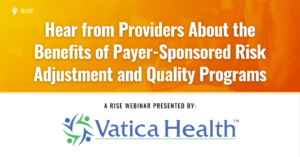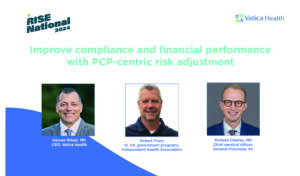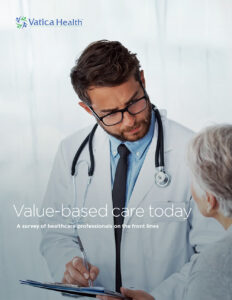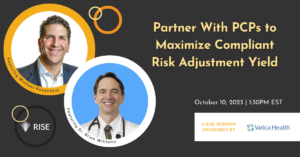As regulatory pressure mounts, health plans face challenges that impact the operations, compliance and results of their risk adjustment and quality programs. It’s become evident that PCPs should be at the center of risk adjustment efforts, but for payers and ACOs, that is easier said than done.
In a recent webinar hosted by Vatica Health for members of the RISE Association, Margaret Paroski, MD, CEO of Catholic Medical Partners, and Brian Flower, vice president of client solutions at Vatica, discussed this topic. You can view the webinar or read on for highlights of the presentation.
Dr. Paroski and Brian agreed that the risk adjustment landscape changed more in the past six months than the past six years. The Office of the Inspector General (OIG) has made clear its focus related to risk adjustment is on single submissions made by someone other than the patient’s care team. Under the RADV Final Rule, coding accuracy and specificity is even more important due to increased fines and penalties. The implementation of V28 under the 2024 Final Rate Notice introduced significant changes to the risk adjustment model including a reduction in the number of diagnosis codes that risk adjust and a shift in coefficient weight for many conditions.
The need to document all active conditions annually has remained constant. Dr. Paroski noted that, for most conditions, the PCP is the best source for that information. Often, the PCP has been caring for that patient for many years and has access to critical clinical data in the EHR. “We ask that you give us resources to help us, don’t try to replace us,” she advised payers.
Benefit #1: maximize compliant coding capture
Dr. Paroski offered several suggestions for payers to help providers code accurately and compliantly. Timely, patient-specific data presented within the provider’s clinical workflow is critical. In contrast, Dr. Paroski noted that surfacing low-probability suspected conditions overwhelms and frustrates providers. In addition, provider education and training is very helpful. Brian agreed, noting that highly focused and practical training, instead of broad and general education, is often more effective.
Benefit #2: improved outcomes
Supporting the patient/PCP relationship with enhanced payer collaboration empowers compliant code capture, improved utilization management, patient adherence and holistic care. This model enables more comprehensive and targeted data accuracy at the point of care with the opportunity for PCPs to close gaps in care by enabling a provider-centric model for value-based reimbursement activity. Payers can support this approach by offering PCPs a clear strategy and sponsored solutions to progress in value-based care (VBC) payment models.
Dr. Paroski suggests health plans find programs that work and build them into VBC contracts. Give providers data that goes beyond risk and HEDIS/Stars data. For example, information on patients’ social determinants of health is extremely helpful to PCPs. Equally helpful are community resources to address these issues, which many payers now offer but PCPs may not be aware of. Conversely, when payers auto-assign members that the PCP has no record of, this wastes the provider’s time and causes frustration. Likewise, when payers offer poor visibility into the provider’s VBC performance, it does not help improve outcomes. More collaboration, communication and transparency between payers and providers drives more accurate and compliant results.
Challenge #1: PCPs are busy
Dr. Paroski used the analogy of an online meal prep and delivery service to describe how payers can help busy PCPs. Blue Apron assembles, preps and premeasures the ingredients so the recipient just needs to follow the directions and cook the meal. Payers should do everything they can to make coding and documentation simple and efficient for PCPS. Allow providers to work at the top of their license, reimburse the staff for additional time, effort and expertise, and support providers with clinical and administrative resources. For maximum efficiency, don’t interrupt the PCP’s day or revenue cycle, interfere with time spent seeing patients, or overburden the clinical staff.
Challenge #2: PCPs do not feel valued
The healthcare system is asking PCPs to take on administrative responsibilities unrelated to why physicians chose the profession. Physicians did not go to medical school to become super-coders. Dr. Paroski noted that payers can help by paying fairly and quickly, and sponsoring programs that support physicians. In addition, payers should examine leveling the playing field for house-call visits so that PCPs get paid a fair amount for their time completing a house call. Given the OIG scrutiny on coding submissions from outside of the patient’s clinical care team, involving the PCP in a home or virtual visit designed to capture HCC codes is preferred. Brian noted home visits initiated by the PCP have a higher success rate in terms of acceptance by the patient and continuity of care.
“Stay in your lane,” Dr. Paroski added. “Don’t carve us out of care decisions or support risk adjustment programs that work around us. We can help fill the potential erosion of HCC RAF scores in the shift from V24 to V28 given our strong relationships with patients and access to all relevant clinical data.”
Dr. Paroski and Brian highlighted these key takeaways for the payers attending the webinar:
- Provide timely, accurate and useful data
- Provide viable VBC contracts and a clear path for evolution of VBC
- Do the work you can do to support PCPs and don’t interrupt providers’ workflows
- Pay providers fairly and quickly for the work they do
How Vatica Health can help
Vatica Health is the #1 ranked PCP-centric risk adjustment and quality-of-care solution for health plans and health systems. By pairing expert clinical teams with cutting-edge technology, Vatica increases patient engagement and wellness, improves coding accuracy and completeness, identifies and closes gaps in care, and enhances communication and collaboration between providers and health plans. The company’s unique solution helps providers, health plans and patients achieve better outcomes, together. With the Vatica team providing the extra resources needed for complete, compliant coding and documentation, physician participation is easier to enlist and sustain. To learn more, visit https://vaticahealth.com/.












